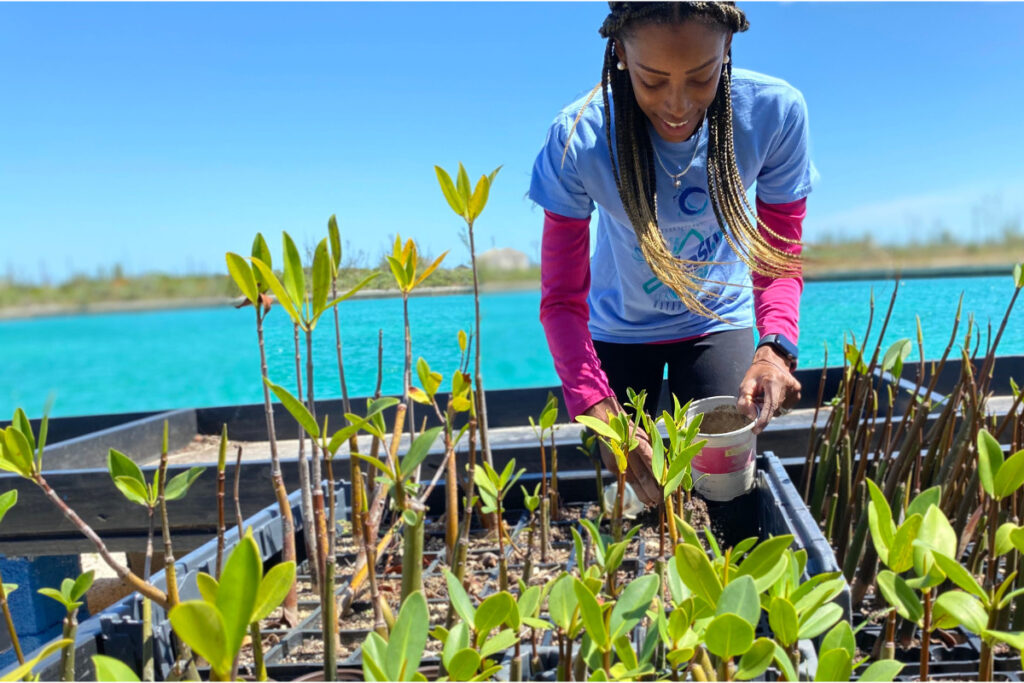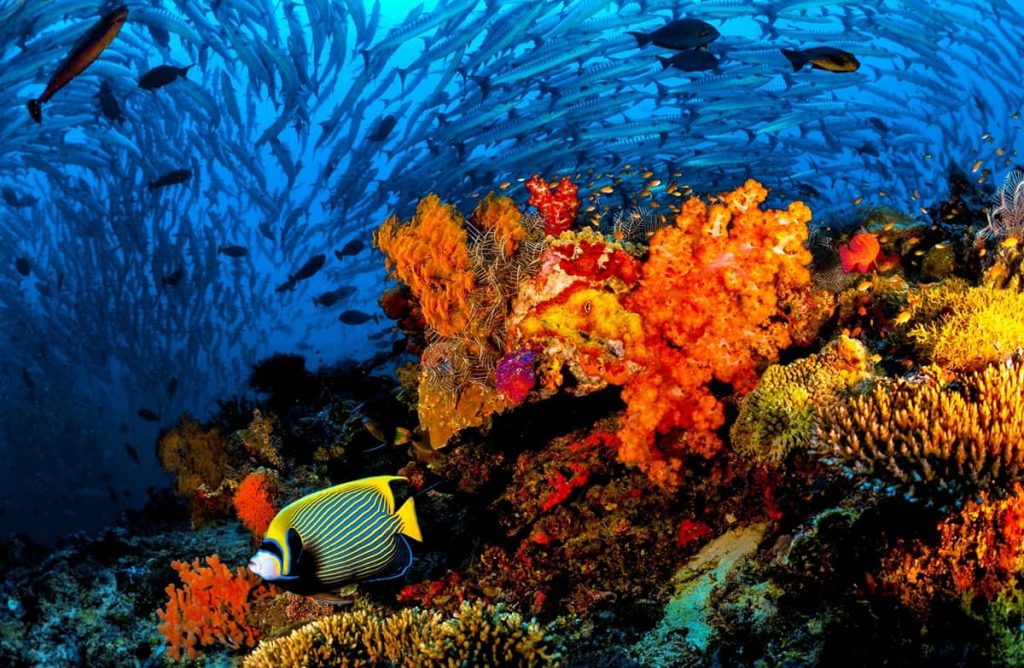Our Caribbean region has some of the most picturesque turquoise blue waters teeming with marine life. Or at least, those that are still living in these ecosystems.
Also known as the Caribbean Islands biodiversity hotspot, the Caribbean is an archipelago of habitat-rich tropical and semi-tropical islands, comprised of 30 nations and territories and stretches across nearly 4 million square kilometers of ocean. But, it is estimated that we have just around 10 percent of the hotspot’s original habitat remaining. In fact, a decade ago, the Caribbean coral ecosystem was classified as “endangered”.

The decline of our natural ecosystems is bad news for our food chains and economies. As many as 100 million Caribbean people benefit from coral reefs, including 41 million people who are highly dependent on reefs for their food or livelihood. Fish and fish products account for an average of 9.9% of the total share of dietary protein eaten in the region. And most notably, the fisheries sector is an important contributor to GDP, from as low as 0.13% in Trinidad and Tobago to a high of 6.85% in Guyana. The amount of living coral cover has decreased by an estimated 50 percent worldwide in the last three decades and some fish rely on coral reef systems for food, shelter, nurseries, and breeding grounds.
Regrettably, coral reefs aren’t the only endangered ecosystems in the Caribbean. The Caribbean’s mangroves reduced by a third in just 30 years. Mangroves provide natural infrastructure to help protect inland populated areas by reducing erosion and absorbing storm surge impacts during extreme weather events such as hurricanes. Furthermore, mangroves are nurseries for fish and other marine life. Despite being out at sea, these marine ecosystems are crucial for our Caribbean people.
The Caribbean Biodiversity Fund’s mission is to ensure continuous funding for conservation and sustainable development in the Caribbean.
How is the CBF protecting the Caribbean biodiversity hotspot?
- Sustainable financing: Since 2016, the CBF has provided for sustainable financial resources to 11 countries from a CBF Endowment Fund through partnership agreements with National Conservation Trust Funds. Around USD 7 million has been disbursed to the Funding for project-based funding and that funding will be continuously renewed as long as the Endowment Fund exists. Through its Ecosystem-based Adaptation (EbA) Facility, the CBF has also disbursed USD 14 million from the USD 35.6 million awarded to implement 27 projects that target coastal and marine ecosystems such as mangroves, wetlands, coral reefs, and coastal watersheds and will benefit 40 marine protected areas directly and indirectly. Beyond existing capital, the CBF also fosters additional resource mobilization. To that end it has attracted, in the past year, EUR 4 million from French donors and USD 7 million from Global Affairs Canada. Both projects aim to achieve the institutional and technical capacity of Conservation Trust Funds and Environmental Organizations in the region.
- Knowledge sharing: the CBF also facilitates networking and knowledge exchange activities that encourage the sharing of best practices and creating synergies in the region such as a recent regional event on coral reef restoration. The Knowledge Sharing Mechanism the CBF has developed to promote and anchor the exchanges of practices and experiences between countries, is the collaboration between CBF and the Conservation Trust Funds with whom CBF has signed a Partnership Agreement, also called the Caribbean Sustainable Finance Architecture. The Architecture is not a legal, independent entity, but rather the embodiment of collaboration, knowledge sharing and networking. The CBF leads on regular networking sessions with the Architecture (both virtual and in-person), shares calls for proposals and other relevant events and knowledge, and manages a repository of technical and institutional documentation.
- The Caribbean Sustainable Finance Architecture: The mechanism developed by the CBF to foster technical knowledge exchange between countries is the collaboration between the CBF and partner Conservation Trust Funds, also called the Caribbean Sustainable Finance Architecture. The CBF leads on regular networking sessions with the Architecture (both virtual and in-person), shares calls for proposals and other relevant events and knowledge, and manages a repository of technical and institutional documentation. Though not a legal, independent entity, the Architecture facilitates knowledge exchange among its Conservation Trust Funds.
- Knowledge exchange among the Conservation Trust Funds: In April 2023, the Grenada Sustainable Development Trust Fund initiated an inter-country exchange on coral reef restoration between Grenada and St. Vincent and the Grenadines with the support of the St. Vincent and the Grenadines Conservation Foundation. Coral reef restoration in many Caribbean countries is still new and the trial-and-error phase of replanting corals is time consuming. With the knowledge sharing on this particular topic, the CBF and its partners aim to accelerate conservation actions and impacts at the national level.

How does the CBF finance projects?
The CBF provides financial resources through eligible National Conservation Trust Funds (NCTFs) who lead the grant-making process at the national level through its Conservation Finance Program. While its Climate Change via its Ecosystem-based Adaptation (EbA) Facility distributes grants directly to local, national and regional projects through competitive calls for proposals to support effective climate change adaptation measures in the marine and coastal zone of the insular Caribbean. The CBF’s newest program, Nature-based Economies through is Advancing Circular Economy (ACE) Facility will work with public and private sector partners as well as other Caribbean stakeholders to fund projects that promote and apply practical circular economy principles to minimize, prevent or remove waste entering the marine environment and or removing marine litter.
Funding from the Conservation Finance Program supports Protected Areas management, infrastructure within and outside Protected Areas for natural resources management, environmental education, community engagement, environmental policy, and research. The projects financed by the Ecosystem-based Adaptation (EbA) Facility under the Climate Change Program restore and rehabilitate ecosystems, reduce land-based stressors, install artificial reefs,and gray-green infrastructure (hybrid solutions) and implement measures to reduce pressures on ecosystems including physical damage to ecosystems. The grantees are selected through a competitive open process.
Currently, the CBF manages over USD 135 million in financial resources for all its programs and projects. The CBF’s visionary approach towards providing sustainable financing for the conservation of the region’s natural resources will result in the protection of our biodiversity at an unprecedented scale for generations to come.
About the CBF
Established in 2012 to create reliable, long-term funding for conservation and sustainable development in the Caribbean region. Today, the Caribbean Biodiversity Fund (CBF) is a regional umbrella environmental fund that uses a flexible structure to implement innovative solutions and consolidate resource mobilization in the Caribbean through a range of financial instruments.
The CBF is facilitating the Caribbean Sustainable Finance Architecture. The Caribbean Sustainable Finance Architecture (“Finance Architecture”)—currently composed of the regional Caribbean Biodiversity Fund (CBF) and a set of 11 National Conservation Trust Funds (NCTFs)—is the realization of a vision to create reliable, long-term funding for conservation and sustainable development that will benefit the Caribbean region for generations to come. The Finance Architecture is designed to support Caribbean nations in meeting important goals that they have agreed to under the Convention on Biological Diversity (CBD), the U.N. Framework Convention on Climate Change (UNFCCC), the Caribbean Challenge Initiative (CCI), and other international commitments.






